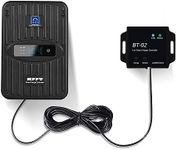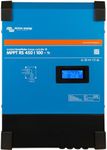Buying Guide for the Best Solar Controllers
Choosing the right solar controller is crucial for the efficiency and longevity of your solar power system. A solar controller, also known as a charge controller, regulates the voltage and current coming from your solar panels to your batteries, ensuring they are charged properly and not overcharged. Understanding the key specifications will help you select the best solar controller for your needs.Type (PWM vs MPPT)There are two main types of solar controllers: Pulse Width Modulation (PWM) and Maximum Power Point Tracking (MPPT). PWM controllers are simpler and cheaper, making them suitable for smaller systems with lower power requirements. MPPT controllers are more efficient, especially in colder climates or when the solar panel voltage is significantly higher than the battery voltage. They are ideal for larger systems where maximizing energy harvest is important. Choose PWM for basic, cost-effective setups and MPPT for more advanced, efficient systems.
Current Rating (Amps)The current rating of a solar controller indicates the maximum current it can handle from the solar panels to the batteries. This is important to ensure the controller can manage the power generated without overheating or failing. Current ratings are typically segmented into low (up to 20A), medium (20A-40A), and high (above 40A). For small setups with a few panels, a low to medium current rating is sufficient. For larger installations with multiple panels, a higher current rating is necessary to handle the increased power.
Voltage RatingThe voltage rating of a solar controller specifies the maximum voltage it can handle from the solar panels and the battery bank. Common voltage ratings include 12V, 24V, and 48V. It's important to match the controller's voltage rating with your system's voltage to ensure compatibility and efficient operation. For small, residential systems, 12V or 24V controllers are usually adequate. For larger, more complex systems, especially those used in commercial applications, a 48V controller may be more appropriate.
EfficiencyEfficiency refers to how well the solar controller converts the energy from the solar panels to the batteries. Higher efficiency means less energy is lost during the conversion process, which is crucial for maximizing the performance of your solar power system. Efficiency is typically expressed as a percentage, with higher values indicating better performance. For most users, choosing a controller with an efficiency of 95% or higher is recommended to ensure optimal energy utilization.
Display and MonitoringMany modern solar controllers come with built-in displays and monitoring capabilities, allowing you to track the performance of your solar power system in real-time. This feature is important for maintaining and troubleshooting your system. Displays can range from basic LED indicators to advanced LCD screens showing detailed information. For users who want to keep a close eye on their system's performance, a controller with a comprehensive display and monitoring options is ideal. For those who prefer simplicity, a basic display may suffice.
Temperature CompensationTemperature compensation adjusts the charging parameters based on the temperature of the batteries, which is important for maintaining battery health and efficiency. This feature is particularly useful in environments with significant temperature fluctuations. Controllers with temperature compensation can automatically adjust the charging voltage to prevent overcharging or undercharging in different temperatures. If you live in an area with varying temperatures, choosing a controller with this feature can help extend the life of your batteries.












![EPEVER MPPT Solar Charge Controller 40A 150V PV Solar Panel Controller Negative Ground W/ MT50 Remote Meter + Temperature Sensor PC Monitoring Cable[Tracer4215BN]](https://images-proxy.bestreviews.guide/RK6ZX0t0vZCpi6nEWQ9teFwpP8Y=/0x150/https://m.media-amazon.com/images/I/41Piu7aIW4L._AC_CX679_.jpg)



